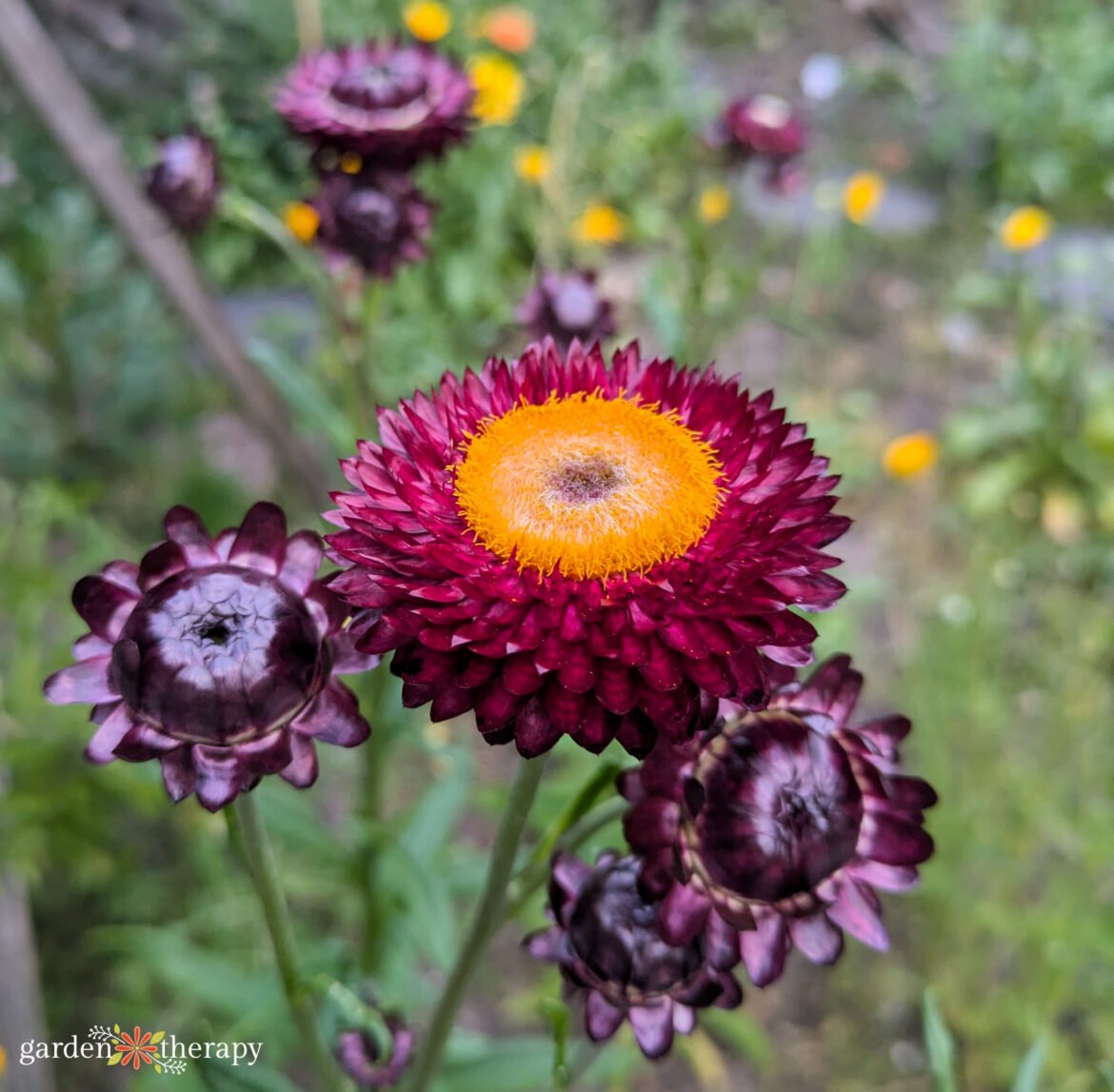Strawflowers are a classic beauty. Florists, home gardeners, and crafters are all obsessed with the papery, bright blooms that look as good dried as they do fresh. Growing them in your garden is simple once you know the tricks!
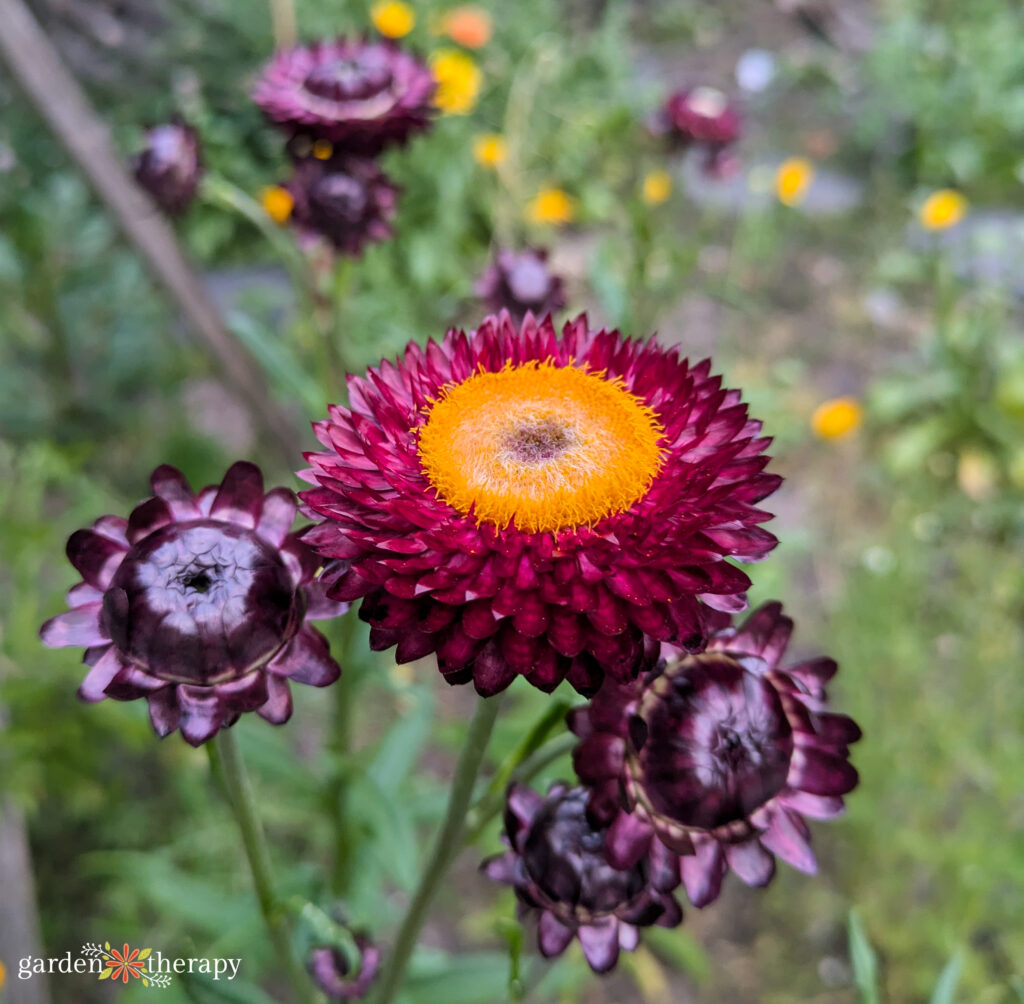
We know how hard it is to pick favourites in the plant world, but I must say, strawflowers are one of my all-time favourite flowers to grow.
I focus a lot on growing cut flowers that I can use to make and sell bouquets. I specialize in dried flowers, so it’s essential to me that many of my flowers also dry well and beautifully.
When it comes to dried flowers, few do it better than the strawflower. It dries pretty well identically to how it looks fresh, retaining the bright, vivid colours and shape of the papery flower.
My first time growing them, I only grew a few. But I quickly fell in love with strawflowers, vowing to grow more the following year. I went from one variety to five!
Strawflowers are easy to grow once you understand them, but they do require a few tricks to be successful. Follow these tips and you’ll become as obsessed with them as I am!
This post will cover…


Expert Tips for Growing Strawflower
Looking for a quick summary? Here are my top tips for growing strawflower that differ from most plants.
- Strawflower seeds don’t store well, and you’ll notice a heavy drop in germination rates if you use old seed. For the best germination, buy new seeds each year.
- Strawflower seeds need sunlight to germinate. Surface sow the seeds when planting.
- Pinch your strawflowers! They benefit well from pinching, encouraging an additional 4-6 branches of flowers.
- Harvest your strawflowers when the first 2-3 layers of bracts are opening or the centre is just starting to show. Any later and they might shatter or discolour.
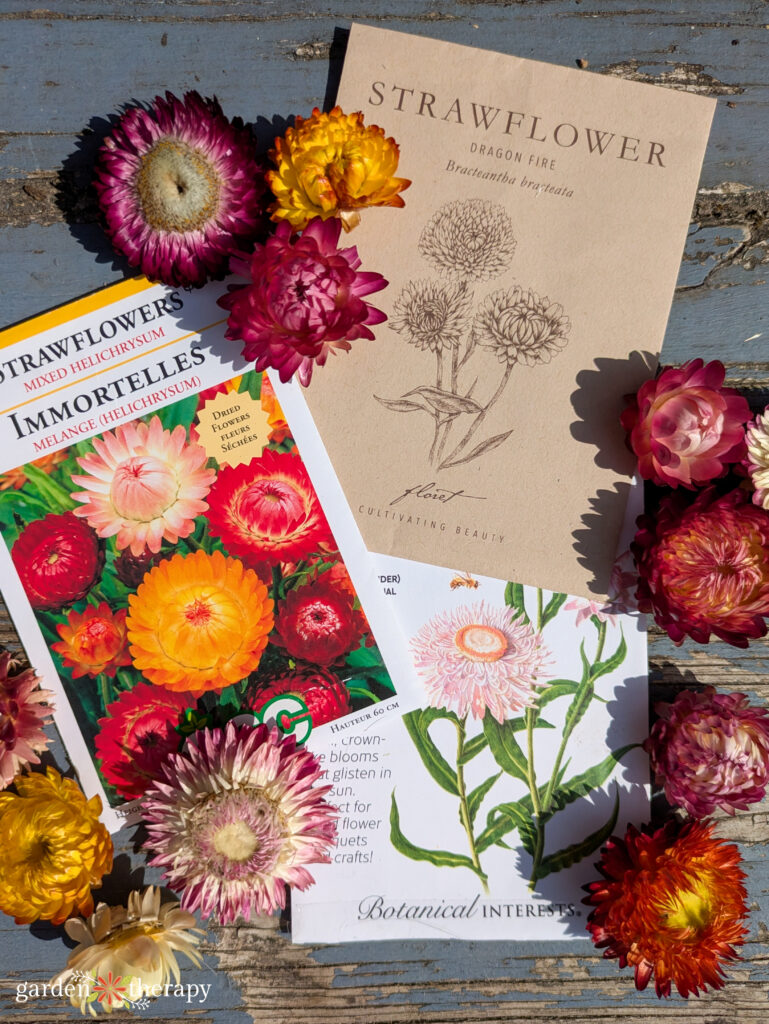

Meet the Strawflower
Originally native to Australia, the strawflower has many names. Its technical botanical name is Xerochrysum bracteatum, though some still refer to it by an old genus classification known as Bracteantha bracteata or Helichrysum. In North America, we refer to it as strawflower, though they’re also called golden everlasting in other regions.
To keep things simple, I’m going to stick to the name of strawflower!
Strawflowers have a large sunny yellow flower surrounded by papery bracts (often mistaken for petals). These papery bracts dry stiffly, which is what makes them one of the most popular dried flowers.
Pollinators love the plant, and deer dislike them. Typically, they’re grown as an annual, though they can be a short-lived perennial in zones 8-11.
The flower blooms from summer to fall. If you live in a hotter climate, you can expect blooms in June. I live in rainy Vancouver, so I don’t start seeing blooms until mid-July. They like a cool start, but they will tolerate warm and dry conditions once they’re established.


Starting Seeds Indoors
While you can technically direct sow strawflower seeds, I recommend you start them indoors—you’ll get better germination results if you do.
Start your seeds inside about four weeks before the last frost. I start mine at the end of February to be planted in mid-April, about 2 weeks after the last frost in my area.
You’ll want to use fresh seed. Compared to other seeds, strawflower seeds don’t store well. The germination rate will significantly decrease in subsequent years.
Surface sow the seeds, since they require light to germinate. I sprinkle the seeds on top of my seed starting potting mix, and then lightly press them into the soil.
For this reason, be careful when watering your seeds, as you don’t want to wash them all away. Bottom watering and misting the top can help avoid this. But make sure to keep the soil moist while growing the seedlings indoors.
The seeds will take 7-10 days to germinate. I like to start mine on a heat mat to help speed things up. I’ve also started them in my Aerogarden, and they grow well in there before I transplant them outside.
Your strawflower seedlings are ready to be transplanted once they are 3-5 inches tall. If it’s cold and wet, you can place them under a cloche or a tunnel for extra protection.
If direct sowing, you can sow them outside 2-4 weeks after the last frost.
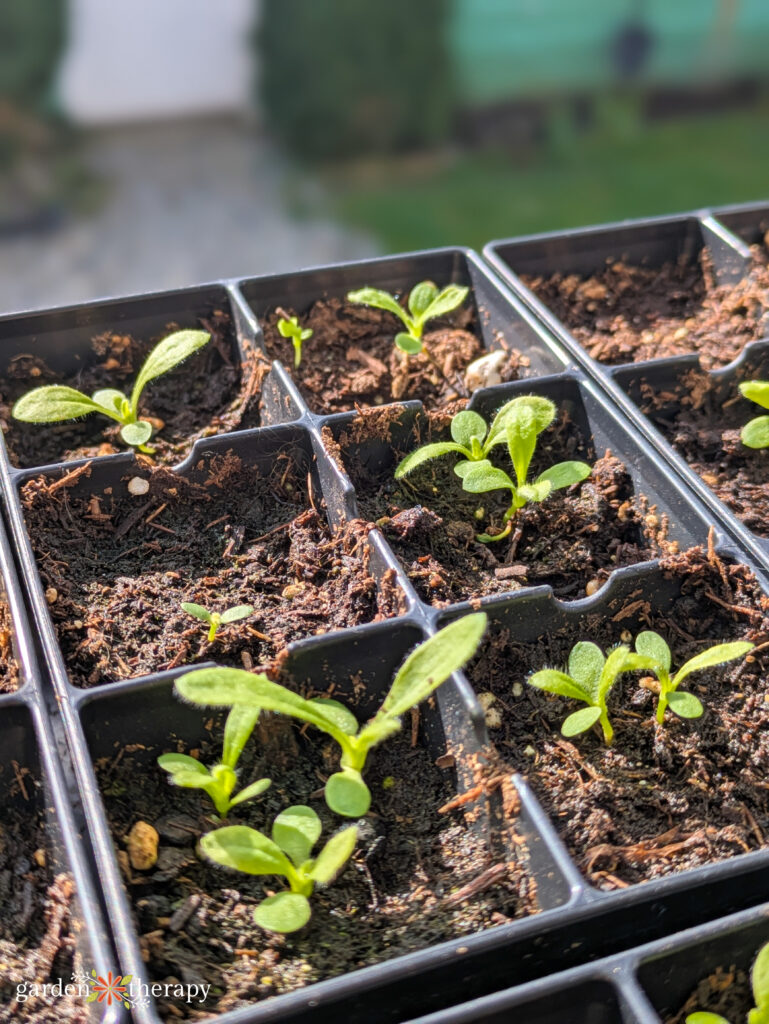

Caring for Strawflower Plants
Strawflowers like well-draining soil. Once established, they do fine on just one to two waterings a week (whether that’s from you or the rain!). Strawflower should be grown in full sun to get the best flowering results, although it can tolerate partial shade.
They should be spaced about six inches apart. I’ve found that many instructions tell you to space 12” apart, but in my experience, they grow quite tall and can be grown closer together. Of course, the height depends entirely on the variety.
On average, you can expect strawflowers to bloom 75-85 days after you start the seeds.
Strawflowers may need staking or a hoop support. You can also fertilize them once a month to encourage blooms, though they aren’t considered heavy feeders, so most quality soils should be fine.
Pinching Strawflowers
I highly, highly recommend you pinch your strawflowers. This is when you remove the centre growth tip of a plant stem to encourage it to grow bushier rather than one stalk.
I know how scary it can be to pinch blooms. After all, they’re finally getting bigger, and the last thing you want to do is set back their growth! But I promise you, it’s worth it. Pinching your strawflower can give you 4-6 stems per branch, which is essential for someone focused on producing lots of cut flowers.
In my first year, I only pinched 50% of my strawflowers as a precaution. The pinched blooms were only set back about one week behind the others, and produced plenty more blooms.
I like to pinch my strawflowers about a week after I’ve transplanted them into the garden. This gives them time to settle in beforehand.


Harvesting Strawflowers as Cut Flowers
While I have found strawflowers fairly easy to grow, the true key to having success with them as a cut flower is knowing when to cut them. In my first year, I would cut them much too late, and they did not dry nearly as beautifully.
Harvest your strawflowers when the stem begins to harden and they’re just beginning to show their centre. The first 2-3 bract layers should be open. Once cut or dried, the flowers will continue to open more. See the picture below for a sample of strawflowers at different stages.
If you harvest when the centre is open and has been pollinated, the flower may shatter or discolour. If the papery bracts are pointing down, they’re too late to be harvested as cut flowers.
Now, most stems will have three or more flowers on them. Harvest the stem when the main, large flower is ready, even if the others aren’t—if they don’t fully open, they still look and dry beautifully as buds since the outer bract layers will open even while the centre remains closed.
Harvest your flowers in the morning after the dew has dried, since this is when the plant is the most hydrated. When used as a fresh flower, they will have a vase life of 7-10 days.
If you want to dry your flowers, remove all the foliage and hang the flower stems in bunches upside down in a warm, dark place for three weeks. You can dry flowers on the stem or just the flower heads to be used in crafts.
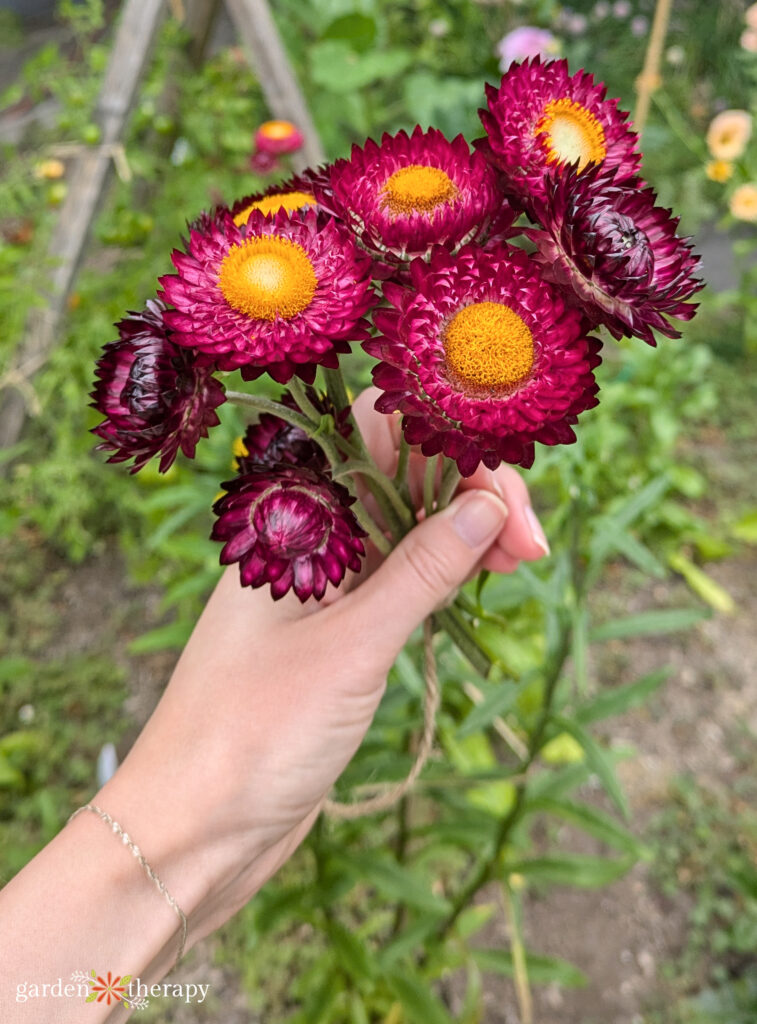

FAQ About Strawflower Plants
Most people grow and treat strawflowers as annuals. However, they can be short-lived perennials in zones 8-11, living for 2-3 years.
There are many different names for the strawflower, and a lot of that comes from confusion that happened over thirty years ago. Originally, it was listed under the genus name Helichrysum. However, in 1990, they added a new genus known as Xerochrysum to which it now belongs.
There is also confusion regarding the genus Bracteantha. This is because one botanist named the genus Xerochrysum in 1990 while another named it Bracteantha in 1991, unaware someone else had already changed the classification. For 12 years, they debated over which would be the correct name, and Xerochrysum ultimately won in the end. However, some people still refer to it as Bracteantha.
So to sum it all up, Helichrysum, Bracteantha bracteata, and Xerochrysum bracteatum all refer to what we call in North America, strawflower.
While strawflowers can self-seed, I don’t find very much success in this. Expect to plant new seeds the following year, and take any reseeding as an added bonus.
Start your seeds inside about four weeks before the last frost. They can be transplanted outside 2 weeks after the last frost in your area.
Alternatively, you can direct sow them outside 2-4 weeks after the last frost.
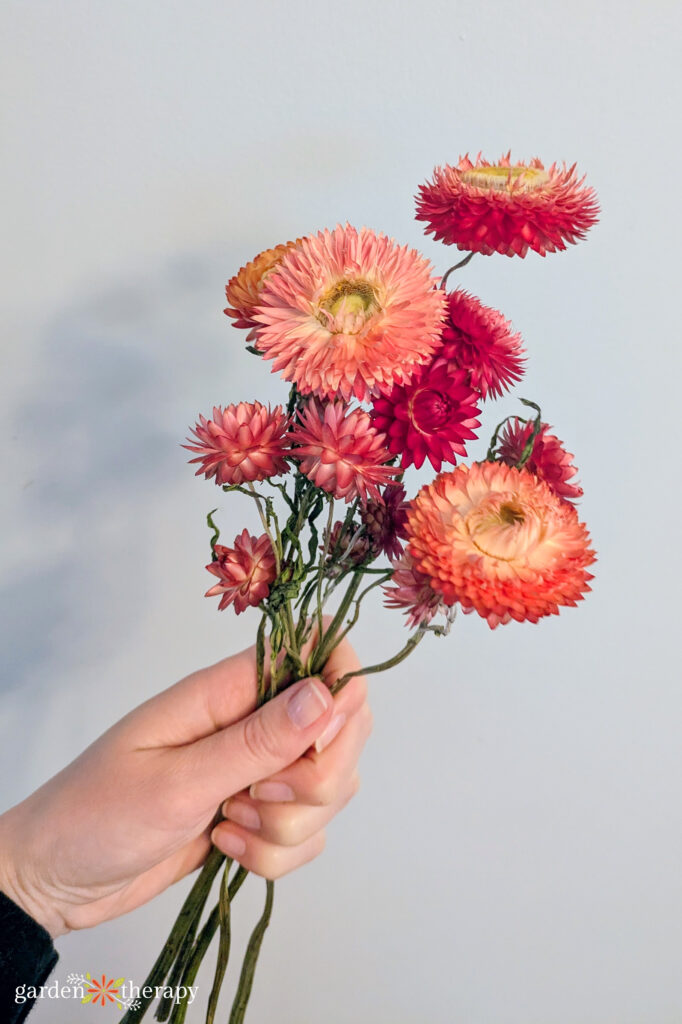

More Cut Flowers to Grow
From Vancouver, BC, Holly is Garden Therapy’s Content Manager. She has a BFA in Writing from the University of Victoria as well as a diploma in Floristry Design from Burnaby CCE. At home, she loves to grow cut flowers and dried flowers for her business, Dirty Daisy Florals, and is an avid houseplant collector and lover of bees. You can find her at @dirtydaisyflorals and @hollyheuversocial.

